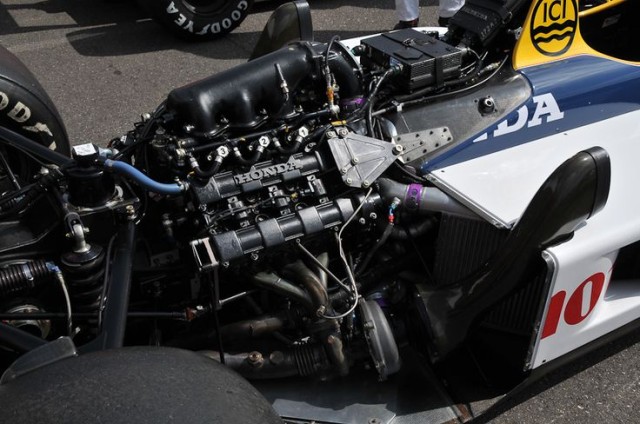The turbo era in Formula One reached its apex in 1986, when boost restrictions had not yet been imposed and full-bore qualifying laps were often a better spectacle than the race itself. With the massive budgets that wealthy multinationals were happy to pour into the sport, development shot through the roof and power outputs doubled since the turbo engine’s inception in 1979.
There were some teams which simply couldn’t muster the money to develop their finicky turbo motors, but Williams was not one of them. With Honda providing the powerplant, the team stood at the front of the grid many times. In fact, in 1986, the Williams-Honda team took pole position four times, just outclassed by Ayrton Senna and his Renault engine, which managed to produce similar levels of qualifying boost. Honda’s engines became the class of the field through a mixture of economy and high power, with which gained the team eleven fastest laps between their two drivers, Nelson Piquet and Nigel Mansell.

Mansell (left) and Piquet (right) flank Frank Williams, who had a hard time managing the two drivers’ mercurial personalities.
In Williams’ case, their Honda engines managed to chuck out an estimated 1,200 horsepower in qualifying, though no one can be certain. Dynamometers of the day couldn’t read figures that high, so these numbers are speculative, but regardless, the little 1.5-liter V6 made enough grunt to spin the Williams FW11’s rear tires in sixth gear. That sort of earth-turning power is clearly visible in the way that the rear end shimmies underneath the incredibly smooth-driving Nelson Piquet’s control.

Piquet’s brilliantly-smooth style, he manages to harness the peaky, brutal power delivery of the Honda RA166E.
Piquet’s qualifying engine, as seen here, was laughingly referred to as a “grenade.” In fact, most of the top teams used “grenades” to attain that desirable pole position, though harnessing the power and the fragility of these powerplants was not easy. With the wastegates blanked off, their expected lifespan was somewhere around four laps — just enough to get the tires up to temperature and then go for it, before melting on the way back into the pits. Seeing as the qualifying tires would work for one lap and then fall off, the drivers had to be totally focused from the minute they left the pits.
Piquet’s lap demonstrates exactly how the finicky, fire-breathing Honda engine had to be harnessed. Even with sticky tires, the cars had to be driven smoothly to apply the power effectively to the ground. Piquet’s butter-smooth inputs, clean throttle application and tidy collection of minute slides have to be praised, because managing those sorts of power levels over the bumpy, undulating surface of Brands Hatch is an impressive feat. There’s a reason why the man won three championships, and as he would be happy to admit, he was never comprehensively the fastest driver around — much of his success came from clever strategy. However, you don’t win 21 races without possessing superhuman speed, and when he chose to employ it, he was stylish in his driving, absolutely committed, and breathtaking to witness.






















